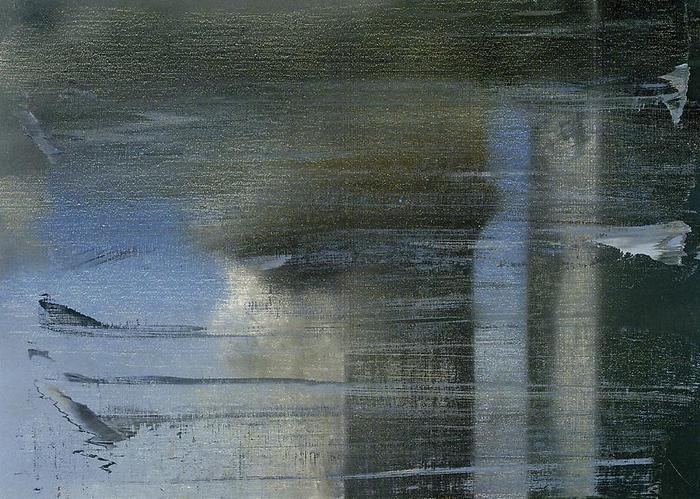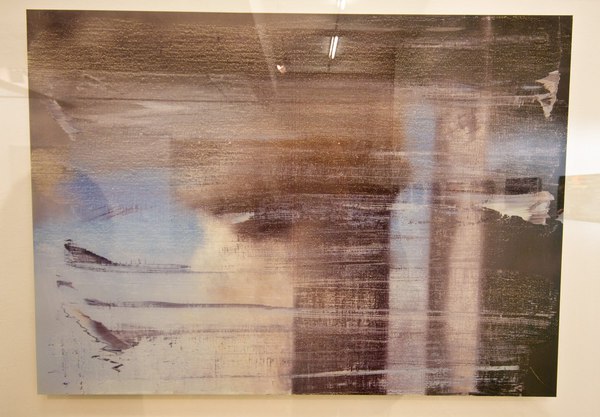tl;dr version: Gerhard Richter made a small painting, September, based on a photo of the WTC getting hit by a plane, and gave it to MoMA, which has never shown it. Then he made a print version, which he sold here and there, and which has been seen in NYC once. The image is the same, but the experience of them is quite different, which is something no one really mentions or talks about. It's almost like the propagation of the image is more important than the actual objects, or than the particulars of seeing them in person. Which, in addition to being the kind of distancing tactic Richter's very fond of, is also a non-trivial observation that can be made about the WTC attacks themselves.
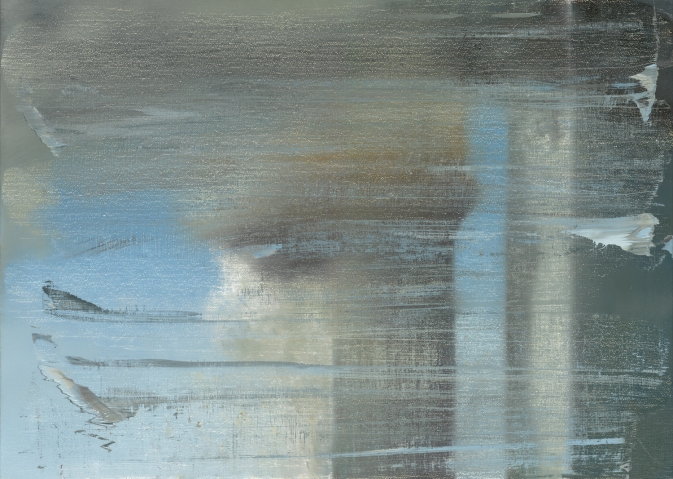
I had not wanted to write about the WTC attacks [or "September 11th"] on September 11th, and though it was the day I actually started thinking about this post, I didn't want to write about Gerhard Richter's September on September 11th, either. And I'm glad I've waited; my reflex was to be a bit cynical, and that has largely dissipated. So.
Richter was in the air on September 11th, traveling to New York and grounded/diverted to Nova Scotia. His eventual artistic engagement with the attacks was a small painting, September [CR: 891-5], above, which he made in 2005. Joe Hage, the collector who is also the instigator behind the artist's ambitious website, acquired a half interest in the painting in order, the story goes, to prevent Richter from deciding to destroy it.
The aura of ambivalence surrounding the painting's existence is of a piece with the painting itself, which is based on a FAZ photo of the hijacked UA175 hitting the South Tower. [A newspaper image the artist didn't see at the time, because he was stuck in Canada. Which means he hunted it down at some point.] Richter knifed and scraped the canvas, deploying abstraction to obscure or even erase the representational image.
As far as I can tell, the small painting, just 52x72cm, dimensions Rob Storr compared to a TV screen, but which I'd say is more computer monitor-size, has never been shown in New York.
It wasn't in Richter's solo show at Marian Goodman in 2005-6, even though squeegee paintings listed before and after it in the artist's roughly chronological CR were. MoMA acquired a dozen of them, a series of abstracts, CR 892-1 through 12, titled Wald/Forest.
When Goodman showed Richter's paintings again in 2009-10, September the painting was not among them. That's when the artist and Hage donated it to The Modern, and when Storr made a video about it. His take on the painting and its context were expanded into a book-length essay published in 2011.
But wait, wasn't it--no. That 2009 show did include a September. But it was a print. As the gallery checklist describes it, a "print between glass". September 2009 turns out to be an enlarged [66x90cm] inkjet on vinyl mounted between two sheets of glass, and published in an edition of 40.
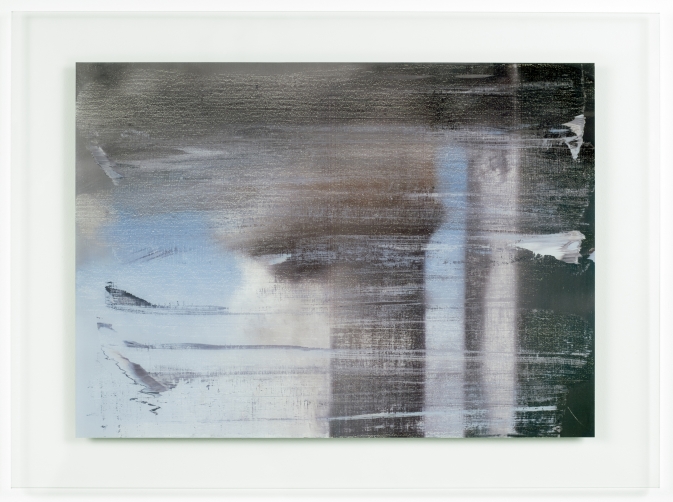
September, 2009, CR 139, digital print between two panes of glass, image: gerhard-richter.com
The gallery's own reproduction of the print leaves out the glass mount; and smooth, sealed surface; and the reflection it inevitably creates. Even though these have to be considered as central elements of this work, as different as can be from the scarred, textured surface of the painting it reproduces.
Here's an installation shot from We Heart New York that shows the gallery and other work reflected in the print's mirror-like surface:
And here's a shot of it installed last year at a retrospective of Richter's editions at Collectors Room, Berlin. It's big and glass and framed, and looks and feels completely different than a painting. Because it's a blown up, face-mounted photo of a painting.

Yet even here, in a show about editions, curator Hubertus Butin mostly talks about September as a painting. And so did Storr. And I confess, I'd seen the Goodman show, and read Storr's book, and seen his interview, but it wasn't until I saw this shot that it even registered with me that there was an edition. And that's what I'd seen, not the painting I thought I'd seen.
When I realized this last week, on September 11th, I felt a rush of cynicism, reading Richter's production of an edition as a sell-out. Just as he donated his Important Historical Image to the Modern, he'd quietly sold 40 copies of it to lesser [sic] museums and collectors. Dallas got one. But then I saw one in Beirut, and it occurred to me that an edition circulates the image in ways that transcend the painting itself. It puts September in more, wider, and more varied contexts than MoMA's loan policy could ever accommodate. [UPDATE: John from BR&S adds that a print was in this 2011 exhibition at Montserrat College of Art. Indeed, it's on the catalogue cover. Storr also spoke.]
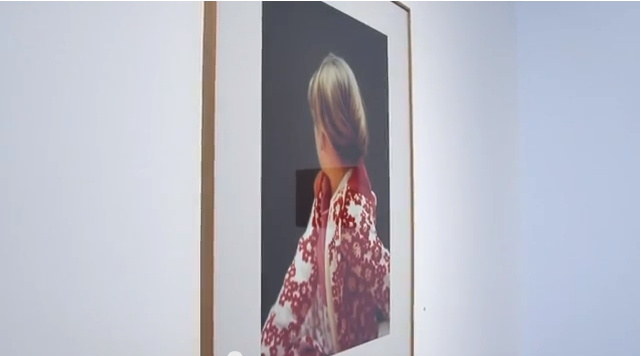
In that video tour, Butin talked about Betty, calling Richter's painted portrait of his daughter the "most famous and probably the most successful picture that he has ever created." Successful, Butin continued, because "No other subject of his has been as frequently reproduced in books, catalogues, postcards and posters." The Betty in his show is, of course, an edition, not the original. It's a print of a photo of the painting [of a photo.] And as an image, at least one metric of its success, is its rate of reproduction.
September the print has exactly the same relationship to September the painting. And even more than a painting, a glassy digital print ends up capturing September's electronic screen essence that Storr originally identified. Which makes me wonder how, why, New York, of all places--of all places--has only seen the print, and not the painting. Not the visceral, physical experience of the original, but the distanced, reflective, mediated simulation. Or maybe it's all incidental to September achieving historic, Betty-scale "success".
September, CR| 891-5, 2005 [gerhard-richter.com]
September, CR 139, 2009 gerhard-richter.com]
September: A History Painting by Gerhard Richter, by Robert Storr [amazon]

